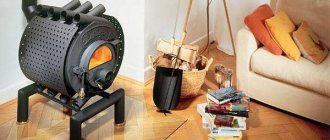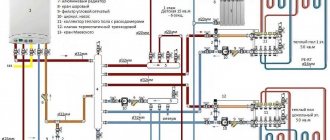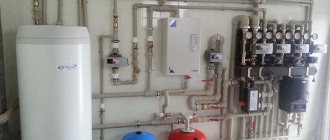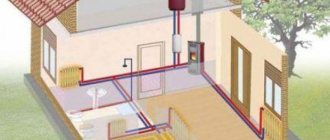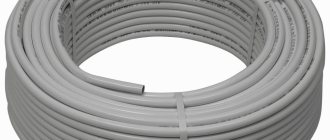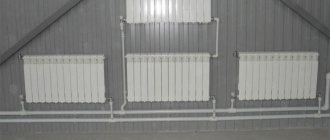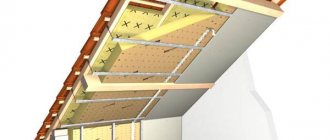Holidays at the dacha are not only a battle for the harvest or barbecue picnics, but also a New Year's round dance around the Christmas tree in the yard and snowball fights. And if in winter you visit your dacha as regularly as in summer, then your house and all its inhabitants need warmth and comfort. Which means it's time to warm up! How to make heating in a dacha is the most common question among lovers of country holidays who prefer warmth and home comfort at any time of the year. Moreover, it is better to start worrying about heating at the level of designing a house.
Water heating has a number of important advantages, such as a simple operating principle (hot water, constantly circulating in the pipes, warms the home) and the absence of the need to stockpile coal and firewood. Water is an excellent heat conductor, cheap and accessible. Pipes for water heating are small in diameter, and therefore such a system can be made even for the smallest country house. The heating operates silently, without disturbing the countryside silence, and the owner has the opportunity to regulate the temperature in the room with his own hands.
Advantages and disadvantages of a water heating system
The main disadvantage of water heating in a private home is the need to purchase a large number of different materials. Namely: pipes, shut-off valves, fittings, radiators, boiler and circulation pump. The latter is not used in all systems.
And other shortcomings that can be described as nonsense if the owner of the house is indifferent to his home:
- Water leaks during operation. Today this situation is rare because plastic pipes have been replaced by plastic pipes. But even they sometimes leak at the junctions with other materials. These are already claims against the installation manufacturer.
- The water inside the system may freeze if it is not drained for the winter. This situation is for houses that are not used during the cold season.
Plastic pipes have solved many problems
Water heating has more advantages, which is why the majority of developers of new houses choose it:
- uniform distribution of heat throughout all rooms;
- installing one heating boiler makes it possible to control the process from one place;
- all equipment, except radiators, and piping can be made hidden. That is, organize a boiler room in the office space, and hide the pipes in grooves on the walls or in the floor. Using a heated floor system generally solves the problem of hidden installation. Even the radiators will not be visible;
- The coolant temperature does not exceed +95°C. And the surface of the batteries heats up to +65°C. You can’t get burned on them; dust doesn’t burn on them;
- water heating produces soft heat.
Heating system with hidden pipe wiring
More information about the coolant and its properties
There is no liquid that is ideal for any heating system. Each of the options presented on the coolant market has specific characteristics, for example, operating temperature range.
If you violate the boundaries of the specified range, the heating system will simply “stop”, and in the worst case scenario, pipes will burst and expensive equipment will fail.
In addition to temperature parameters, pipeline fluid has properties such as viscosity, anti-corrosion, and the ability to release toxic substances. An analysis of the required qualities showed that the best liquid coolants are purified water and a special chemical solution - antifreeze.
The table shows the main advantage of ethylene glycol-based antifreeze - the maximum freezing point is -40ºС, while water turns into ice already at 0ºС
Filling with antifreeze is necessary in houses that are not a permanent place of residence. Usually, when leaving a building during the cold season, owners drain the water to avoid accidents and equipment breakdown. There is no need to remove antifreeze - upon return, you can immediately turn on the boiler without fear of leakage or rupture.
At extreme temperatures, the chemical coolant, having changed its structure, retains its original dimensions. Simply put, it turns into a gel that retains its properties unchanged. When the temperature reaches a comfortable level, the gel-like structure becomes liquid again, completely retaining its original volume.
Some more useful information about antifreeze:
- lasts at least 5 years, one fill can withstand 10 heating seasons;
- fluidity is 2 times higher than that of water, therefore, it is necessary to monitor the tightness of the connections;
- increased viscosity requires the installation of a more powerful circulation pump;
- the ability to expand when heated entails the installation of a volumetric expansion tank.
And you must always remember that the chemical solution is toxic and dangerous to human health.
Antifreeze for filling into home heating systems is sold in plastic canisters with a volume of 10 liters to 60 liters. The average cost is from 750 to 1100 rubles. for 10 l
Despite the outstanding characteristics of antifreeze, water is more popular as a coolant. It has the highest possible heat capacity, which is approximately 1 kcal. This means that the coolant heated to 75ºC, when cooled in the radiator to 60 ºC, will release about 15 kcal of heat to the room.
Water is available. If you equip your water supply system with reliable filters, you can use a free option - water from your own well. It does not contain hazardous chemical compounds and will not cause poisoning in the event of an accident.
The negative side of water is that it contains some mineral salts that cause corrosion. The problem can be solved by simply boiling it or using rain water (or melt water) instead of well water.
There are complex systems for purifying and preparing water for a private home: in addition to universal purification, water goes through several stages to become potable or suitable for pouring into the heating circuit (+)
Water is not recommended for use in houses for periodic residence.
Features of a water heating system
From the name itself it becomes clear that the coolant in this case is water. This is the environment that accumulates thermal energy well and releases it easily. It has a high heat capacity, expands when heated, but contracts poorly when pressure increases. Water density is 950 kg/m³. The principle of operation of water heating is quite simple. The water is heated in the boiler, and then moves through pipes to the radiators, where it gives off its heat, and returns through the return circuit to the boiler.
How the coolant moves through the heating system
The main task of the heating assembly is to force the coolant to move along the circuit. Therefore, there are two types of heating systems: with natural circulation of coolant and with forced circulation. In the first case, water moves through the pipes under the influence of physical laws, when the warm medium rises up and the cold medium goes down. In the second, movement occurs due to the operation of the circulation pump. But more on that below, and now let’s look at what materials and equipment are best to choose for installing water heating.
Installation of heated floors
Installation of infrared floor heating does not require any special conditions and can be carried out both in warm and cold seasons. Installation work does not require special skills and is easy and simple. First you need to buy infrared film, hydro- and thermal insulation, a thermostatic block and covering material; the best option is laminate.
The installation proceeds as follows:
- the floor surface is cleaned and leveled;
- the thermostat is installed so that it is convenient to use;
- thermal insulation is laid and secured with mounting tape;
- the strips are laid according to the instructions in the instructions, the surface in the places where the furniture is placed is not lined;
- pieces of film are fastened together, and the cut points are isolated with bitumen tape;
- power supply is connected to the heating elements, and from it to the temperature control unit;
- the system is tested for readiness for operation;
- waterproofing is laid, and a floor covering of your choice is placed on it: laminate, carpet or another option.
Basic elements of water heating
The water heating system includes:
- heat generator, also known as a boiler or furnace;
- pipes;
- radiators;
- circulation pump;
- expansion tank.
Complete set: boiler, radiators, pump and expansion tank
Heating boilers
Before purchasing and installing a heating boiler in a private home, you need to calculate its power. This indicator reflects the amount of thermal energy supplied. And the larger the area of a private house, the more powerful the equipment must be installed.
Gas generator for heating a private house
It is easy to calculate the power of the unit. To do this, you need to know one ratio - for 10 m² you need 1 kW of thermal energy. This takes into account that the height of the ceilings in the rooms is no more than 3 m. But it is necessary to understand that this ratio will act differently in different climatic regions. Therefore, SNiPs contain climate coefficients.
| Region | Northern | Middle lane | Southern |
| Coefficient | 1,5-2,0 | 1,0-1,2 | 0,7-0,9 |
For example, the total area of a private house located in Murmansk is 100 m². The boiler power is determined as follows:
- 100 / 10 = 10 kW;
- 10 x 2 = 20 kW , where “2” is the northern coefficient.
Liquid fuel boiler assembly
Now, regarding the classification. Heating units are mainly divided according to the type of fuel used: gas, electric, solid or liquid fuel. If gas is installed in the house, then this is the best option. All other types are considered taking into account what is beneficial. If the power supply is inconsistent or the network voltage is weak, then it is better to give preference to solid fuel boilers. By the way, the latter are not only wood-burning structures, they are modern pellet options, which have wider functionality and higher efficiency.
Solid fuel wood boiler in operation
Attention! Purchasing a boiler is not cheap, so fireplaces and kitchen stoves in which a heat exchanger is installed can be used as heating generators.
Electric heating boiler
Related article:
Long-burning wood-fired boilers for the home. From this publication you will learn everything about wood-burning boilers, their types and nuances of use.
Pipes
Everything is simple here - you only need to use the plastic version. Pay attention to its temperature limit for use. Because there are pipes for cold water and for hot water. In heating, the second position is used.
Plastic pipes for heating
You can talk about the diameter of the pipes only after a full calculation of the system. But first we can say that material with a diameter of less than 40 mm cannot be used for the supply and return circuits. Radiator connections are products with a diameter of 20-25 mm.
Related article:
Heating pipes: which ones are better. Varieties of products, their advantages and disadvantages, how to choose the right diameter, how to insulate - you will find all this and much more in our publication.
Radiators for heating
Manufacturers today offer four types of heating batteries:
- cast iron,
- steel (tubular or panel),
- aluminum,
- bimetallic (steel pipes inside, aluminum on top).
Cast iron radiator - accordion
Related article:
What heating radiators are best to install in an apartment. In this review we will look at the types of radiators, their advantages and disadvantages, popular models and manufacturers.
Each type has its own pros and cons. For example, cast iron heats up slowly, but retains heat for a long time. Aluminum heats up quickly, gives off the most thermal energy, but quickly corrodes. In this regard, the best option is bimetallic or steel, as the golden mean.
Steel tubular radiator
It is important to calculate the required number of battery sections, because this value determines how much heat will be released into the rooms of the house. It is not difficult to do the calculation yourself. To do this, you need to know the area of the room, the average heat transfer value of one section, and also take into account the ratio of the area of the room and the heat transfer from the radiator. The latter is the range of 60-200 W depending on the climate region.
Aluminum model with the highest heat output
For example, the area of a room is 20 m², the average heat transfer value of one section is 170 W, the ratio is taken to be 100 W. The last two indicators can be found in SNiPs. Now we carry out the following mathematical operations.
- 20 x 100 = 2000 W of heat will be required to heat the room;
- 2000 / 170 = 11.76 pieces or 12.
That is, it turns out that in order to heat a room of 20 m², you will need a radiator battery with 12 sections. Of course, this is an approximate calculation, because the ceiling height and battery type were not taken into account.
Bimetallic batteries with high heat dissipation efficiency and long service life
| Cast iron | Steel | ||
| pros | Minuses | pros | Minuses |
| High heat capacity | High specific gravity | High strength | They are afraid of water hammer |
| Long service life | Exclusive models are very expensive | High heat dissipation | In the absence of water, corrosion processes begin to occur |
| Withstands pressure up to 22 bar | Unpresentable appearance of accordions | Two types: tubular and panel | |
| Low price | Low impact strength | Low price | |
| Requires a small volume of coolant | |||
| Aluminum | Bimetallic | ||
| pros | Minuses | pros | Minuses |
| Highest heat output | They are afraid of water hammer | Withstand high pressure | Not the highest heat transfer compared to other models |
| Low specific gravity | Subject to corrosion | Easily cope with water hammer | Not the lowest price |
| Short service life | Very easy installation | ||
| High resistance to corrosion processes | |||
Especially for our readers, we have developed a convenient calculator for calculating the number of radiator sections.
Calculator for calculating the number of heating radiator sections
Expansion tank
Before heating a private house, you need to think through all the positions so that the end result does not disappoint. Therefore, choosing the type and volume of the expansion tank is the most important component of the installation process. Its only purpose is to absorb water, the volume of which has increased due to heating. An additional function is to remove air from the system.
Expansion tanks for heating are always red
The expansion tank can be open or closed. The first is a regular container with an open top end. That is, water comes into direct contact with air. It is usually installed above all other heating units. Warm water gradually evaporates through the open neck, so it will need to be added periodically. The second is a sealed vessel, inside of which there is a rubber membrane. Stretched by water, it creates pressure inside the system, which helps the movement of the coolant. Typically, a closed model is installed with a circulation pump. There is no mandatory requirement to install high. That is, the tank is installed in any convenient place.
As for its volume, this figure is 15% of the coolant volume. The latter is not easy to calculate. You will have to find out the volume of water that is placed in the boiler (in the passport data), in the radiators (ibid.), in the pipes. The latter will need to be calculated using the formula for the volume of cylindrical figures, taking into account the length and diameters of the pipes. It is much easier to use a calculator specially developed by our team, which takes into account all the complexities of the calculation.
Calculator for calculating the volume of an expansion tank for a heating system
Circulating water pump for heating a private house
This device is used only in systems with forced circulation of coolant. It is convenient because pressure is created inside the pipework, which increases the speed of water movement. In this way, the coolant is evenly distributed over the radiators.
Circulation pump for moving coolant
The main parameter of a water pump for heating a private house is performance. To calculate it, the formula is used: Q = N/1.16x(tout-tin), where N is the power of the generator, tout and tin are the coolant temperatures at the outlet and inlet of the boiler, “1.16” is the heat capacity of water. Temperature difference is a parameter that needs to be measured. But it is impossible to do this if the heating system is not yet turned on. Therefore, there are average indicators.
| Heating type | Radiator | With installation of convectors | Warm floor system |
| Temperature difference, C | 20 | 15 | 5 |
How to install the pump correctly
Circulation pump performance calculator
Circulation pump pressure calculator
Boiler designs
When choosing a heating device, you should primarily consider the type of energy carrier. When considering this issue, you should pay attention to its cost and the possibility of its delivery. The second most important factor influencing the choice of boiler is the power of the equipment. On average, it is considered that for heating 10 sq.m. The room area required is 1 kW.
When designing a country heating system, it is necessary to take into account the installation location of the boiler equipment. It is recommended to take it outside the house and place it in an extension. In any case, the specific installation conditions determine the method of placing the boiler.
Let's consider options for heating equipment for a summer residence.
Liquid fuel boilers
Such units run on diesel fuel or waste oil. The latter option is more preferable, since the cost of fuel is significantly reduced. Liquid fuel equipment is attractive not so much for its efficiency as for the possibility of fully automating its operation. Using diesel fuel does not allow for cost savings. At lower temperatures, fuel becomes more viscous, which prevents a stable combustion process. Such a boiler requires the construction of a separate room, since its operation is accompanied by loud noise.
Liquid fuel boiler
Solid fuel boilers
Despite the fact that it is necessary to constantly replenish firewood, the cost of solid fuel is not comparable with liquid fuel, and even more so with electricity and gas. You can save money by collecting dead wood in the nearest forest belt.
The disadvantage of this type of fuel is that it burns out quickly; one fill is enough to operate the boiler for no more than six hours. Installing pyrolysis boilers increases the operating time of the equipment on one bed, but it is not practical to use them for a small area.
It is impossible to regulate the combustion temperature in solid fuel boilers. There is only one way to influence the combustion process: change the air supply using a damper. In addition, to store fuel reserves, the premises must be organized in a certain way.
Classification of water heating systems
As mentioned above, heating is divided according to the method of movement of the coolant into: natural circulation and forced.
Heating system with natural coolant circulation in a one-story house
Let’s immediately make a reservation that a heating system with natural circulation is best used in one-story houses. The thing is that the coolant cannot rise high even at a temperature of +95°C. Of course, no one limits the height of the distribution; it’s just that the system itself will work ineffectively.
Schematic diagram of heating with natural circulation of hot water
The essence of natural circulation is the movement of water under the influence of the laws of physics. But there is one nuance here that you need to know when installing heating yourself. This is the slope of the horizontal contours from the boiler towards the radiators and from the radiators to the boiler. This figure should be at least 0.5%. That is, this is enough to force the water to move by gravity.
Attention! The advantage of this scheme is complete independence from electricity.
What you need to pay attention to when installing heating without a pump:
- The boiler must be located in the lowest place relative to all pipework. The optimal height difference is 0.5÷1 m.
- The expansion tank is installed above the entire pipework. The height difference is up to 0.5 m.
- The riser leaving the boiler must be directed vertically upward.
- The speed of coolant movement in the system must be no less than 0.1 and no higher than 0.25 m/s. To achieve this, it is necessary to accurately calculate the diameter of the pipes used, taking into account the temperature of the water at the outlet and inlet.
- If heating of this type is equipped with a closed expansion tank, then it is installed at the level of the boiler. In this case, it is necessary to install an air vent into the system, which must be installed at the highest point of the pipe distribution.
Scheme with forced water circulation
Heating diagram for a one-story house with forced circulation of coolant
This scheme differs from the previous one not only in the presence of a pump, but also in the location of the pipes. There is no need for installation at an angle. This is very important for those who are assembling a heating circuit for the first time.
But there is one very important nuance in this system.
Attention! The pump must be installed on the return circuit near the boiler. It is in this area that the coolant temperature is lowest. And this is important for the pump, or more precisely, for its rubber gaskets and cuffs, which simply cannot withstand high temperatures. They will begin to shrink and burst, which will lead to leaks and failure of the pumping unit.
Correct pump installation location
It should be noted that the heating scheme with forced circulation can be used not only for one-story houses. If you accurately calculate the power of the circulation pump, it will easily pull several floors. Although experienced plumbers recommend installing several boilers with separate pumps for a large house with several floors.
Related article:
Heating a country house: options and prices. A separate review provides a comparative analysis of various heating methods with tips and recommendations.
Choosing pipes
In this matter, much depends on the financial capabilities of the owners:
- Steel is an inexpensive option, but is characterized by susceptibility to corrosion and is therefore not very durable.
- Copper is the most expensive metal, easily withstanding both pressure changes and a low-quality coolant that can serve for decades without changing its original characteristics.
- Metal-plastic is a modern material characterized by sufficient strength at an affordable price. The pipes are flexible, which simplifies the installation process. The main disadvantage is the possibility of damage in the event of a sudden temperature change.
- Polypropylene. Plastic modern material that can withstand shock, pressure and temperature changes. During installation, a special heating device is used to form seams similar to welding.
Radiator connection diagrams
For ordinary people who do not think about how radiators are connected in their own home, it does not matter what circuit is used. The main thing for them is warmth in the house. But, as practice shows, it is the connection diagram of radiator batteries that affects the quality of heat transfer. And there are two schemes: one- and two-pipe.
How to make a one-pipe heating system for a private house with your own hands
First of all, you need to understand why it is called that. In essence, a single-pipe is a ring with a boiler in the center. The pipes are laid close to the floor in a circle, with batteries connected to them. Each of them takes the coolant from one side from the lower pipe and squeezes out already cooled water into the same pipe from the other opposite pipe (lower).
Let's face it, it's not the best option, because it has one significant drawback. The radiators far from the boiler receive coolant with a significantly reduced temperature. That is, the batteries closest to the boiler will be hot, the ones farther away will be warm. This means that some rooms will be cool.
Single-pipe with connection of radiators to one circuit
But if a private house is small with 3–6 rooms, then a single-pipe heating system in it is justified due to the ease of installation with your own hands, plus a small number of pipes, shut-off valves and fittings. That is, this is the most economical option in terms of construction. Although the scheme and procedure for installing single-pipe heating are considered simple, the responsibility of the operations carried out is still high. This is especially true for systems with natural coolant circulation. Here it is important to accurately observe the slope of the pipework.
Two-pipe scheme
This water system is more complex for installation work, plus it uses more materials. But it works much better than a single-pipe one. Purely structurally, the layout of the pipes in it consists of two circuits: supply and return. It should be noted that both pipelines are blind and are connected to each other only through radiators and a heating boiler. From the names themselves, it becomes clear that heated coolant is supplied to the radiators through the supply circuit, and cooled coolant is discharged to the boiler through the return circuit.
In this case, radiators can be connected to the supply circuit in different ways. Option one is a circuit with lower wiring. This is when the coolant supply pipe runs along the floor with a connection to the upper radiator pipes. The return is carried out right there, but with a connection to the lower pipes of the heating batteries.
Two-pipe with bottom wiring
The second option is a top-wiring scheme. This is when a pipe riser is drawn upward from the boiler, which goes into a circuit that distributes the coolant to the radiators. The latter is mounted under the ceiling or in the attic. The return line is installed, as usual, at floor level or in the basement.
Attention! All pipes in unheated rooms (attic) are thermally insulated.
It is necessary to indicate that the upper distribution is two options for distributing pipes from the riser.
- When one horizontal pipe is laid, and risers of small diameter pipes are lowered from it to the radiators from above.
- When a collector is installed on the riser, from which each battery has its own circuit. Such a system is called a collector system. Although people often hear other names - spider or ray circuit. By the way, experts believe that this is the best option for a private home if the task is to install heating yourself. It is the most effective, but also the most expensive in terms of pipe consumption.
Two-pipe with top wiring
Pay attention to the photo above. It clearly shows sections of the heating system, where “1” is the general circuit, “2” is the main riser from the boiler, “3” is a horizontal section with a slope, usually located in the attic. “4” are risers that supply coolant to the radiators. “5” are risers that remove coolant from the batteries and “6” is the return line.
And there are two more types of two-pipe systems - with horizontal wiring and vertical. The first is used for one- or two-story buildings, the second for multi-story ones. A distinctive feature of the second before the first is the presence of a high riser, from which supply circuits are distributed among the floors.
The best refrigerators for a summer residence with two chambers
A standard two-chamber refrigerator for a summer residence is relevant in cases where the owners live in it seasonally - almost six months. They also like to often visit a country house and invite relatives and friends to visit.
This technique has good capacity, a rather large freezer, and at the same time moderate dimensions.
Beko CNMV5310EC0S – modern electronically controlled refrigerator
5.0
★★★★★ editorial assessment
87% of buyers recommend this product
See review
The CNMV5310EC0S model from Beko is a high energy efficiency refrigerator with an additional Eco-Fuzzy system that reduces electricity consumption. It has an electronic control system and a display located at the top of the door.
The device has 2 fans with independent installation that prevent the formation of ice. Thanks to this system, the refrigerator practically does not need defrosting.
The model is equipped with a vegetable drawer with built-in blue lighting, which preserves vitamin C and prolongs the freshness of food. The antibacterial coating on the seal prevents the development of bacteria.
With a small width of 54 cm, the refrigerator has increased capacity (310 l). The freezer is located at the bottom.
Advantages:
- Electronic control with display;
- Eco-Fuzzy system;
- Double-circuit cooling;
- Auto defrost;
- Antibacterial coating;
- Increased capacity;
- Blue backlight.
Flaws:
No ice maker.
The ultra-modern Beko refrigerator is suitable for those who plan to store a large amount of fresh and frozen food in their country house.
Tesler RCT-100 – compact two-chamber
4.8
★★★★★ editorial assessment
85% of buyers recommend this product
Despite the small dimensions of this refrigerator, it can boast a full-fledged freezer with a capacity of 30 liters.
The usable space in the main chamber is 65 liters. Thanks to two glass shelves, a drawer for fruits and vegetables, as well as shelves on the door, it can store a considerable amount of food.
The height of the model is only 83 cm, and the width is slightly more than 45. This equipment will easily fit even into a small kitchen. And the classic design makes it suitable for any interior style. The refrigerator comes with an ice tray and a cleaning scraper.
Advantages:
- Compact dimensions;
- Classic design;
- Vegetable drawer;
- Drip defrosting system;
- Shelves on the door;
- Economical electricity consumption.
Flaws:
Non-reversible door.
Tesler RCT-100 is a classic country refrigerator with freezer. Suitable for those who come to a country house periodically.
Gorenje RF 4141 ANW - a budget model for the garden
4.5
★★★★★ editorial assessment
83% of buyers recommend this product
See review
The spacious refrigerator with a total volume of 207 liters has a top-mounted freezer compartment. With a width and depth of 55 cm, it will fit even into a small kitchen and allow you to store a large amount of food.
Inside there are 3 shelves and a drawer for vegetables. There are also storage spaces on the door. The freezer is also divided into 2 parts by a shelf. Thanks to the drip defrosting system, the refrigerator does not require maintenance.
Advantages:
- Low price;
- Box for fruits and vegetables;
- Drip defrosting system;
- Autonomous temperature preservation up to 15 hours;
- Reversible door.
Flaws:
No antibacterial coating.
Those who do not want to overpay for unnecessary functions, but need a spacious refrigerator outside the city, should pay attention to the RF 4141 ANW model from Gorenje.
DIY heating schemes in a two-story private house
Two-story private houses are the most frequently erected buildings today. Therefore, a large number of people are faced with heating issues, or more precisely, the choice of its scheme. It is recommended to use a vertical two-pipe installation with either natural coolant circulation or forced circulation.
Natural circulation scheme
This scheme is a boiler in the basement, from which a riser is led to the attic. There, pipes are routed through radiators, which are usually located on top of each other on the second and first floors. That is, it turns out that two radiators on two floors are connected to each other and form one riser, which is connected to the return circuit in the lower part.
Floor-by-floor vertical movement of coolant to the boiler
It is clear that with such a scheme, the main thermal energy will be given to radiators on the second floor. But the difference will not be significant, so it will not be felt much.
Forced circulation circuit
In this case, it is necessary to organize the wiring so that it is horizontal on each floor. That is, both the supply and return circuits are laid under the heating radiators. Moreover, each radiator is connected to both the first and the second.
The coolant is distributed across floors through a small riser, the height of which is limited by the floor of the second floor. That is, it will be a continuation of the supply circuit on the second floor. At the first, a branch is made from it towards the horizontal wiring.
Heating scheme on two floors with forced circulation
This DIY heating scheme in a private house will work well with natural circulation, but it doesn’t hurt to be on the safe side. The circulation pump will evenly supply hot water through the circuits. Therefore, you can make a bypass. This is a bypass pipe through which water will move in addition to the pump. That is, such a scheme can also work as a natural one. And how forced.
Filling without heating
We looked at the most common options for heating concrete, however, winter concreting can be done without heating. This method is good because it does not require the supply of electricity and the installation of heating systems, which speeds up the construction process.
The principle of this technology is to use special additives that reduce the freezing point of water, as well as speed up the hardening process of concrete so that the solution does not have time to freeze. At the same time, the strength of the material does not suffer at all.
Pouring concrete in winter without warming up - building a foundation
Among other advantages of using this technology is the prevention of efflorescence.
An example of such compositions is the Morozostop additive. To ensure frost resistance of the mixture with its help, you just need to add the required amount of the substance, which is indicated on the packaging. The price of such an additive is quite affordable, so the cost of concrete practically does not increase.
These are, perhaps, all the main nuances that you need to know about warming up concrete and pouring it in the winter if you decide to do construction at sub-zero temperatures.
Types of water heating
Everything that was said above mainly concerns radiator heating of a private house. But there are two more types: underfloor heating system and baseboard radiators.
Warm floor
The attitude towards warm floors is ambiguous. On the one hand, this is actually the best option for uniform heating of rooms. On the other hand, if the floor base is not washed frequently, then dust will always rise up. For allergy sufferers this is a big problem.
Heated floor pipework
But heated floors are used, especially since it is in private homes that they have the optimal operating mode. In principle, there is nothing complicated in installation. You just need to choose a pipe laying scheme, because the circuit will be quite long, and the coolant passing through it will gradually cool down. That is, in the end there will be no trace left of its temperature (and this is no more than +55°C). Therefore, most often the pipe is laid either with a snail or a double snake.
Attention! Heated floors are a heating system with forced circulation of coolant.
Laying schemes for heated floors
Related article:
Installation diagrams for water heated floors in a private house . What types of underfloor heating schemes exist? What are the advantages of each type? Which one is right for you? Read!
Before installing “warm floors” in a private house, you must first insulate the floor base itself. Without insulation, most of the thermal energy will go into the concrete floor. That is, efficiency will decrease. This suggests that heated floors are a costly construction.
You only need to lay heated floors on top of insulation.
Baseboard heating
A warm baseboard is a kind of symbiosis of a warm floor and radiators. In appearance and internal design, it is a compact metal radiator; in terms of the connection method, it is a heated floor. Purely structurally, it is a copper pipe on which aluminum or steel plates are mounted, performing the functions of heat-reflecting ribs. Everything is covered with a metal casing on top.
Heating baseboards around the perimeter of the room
The devices are installed along the perimeter walls or only along the outer walls; they are connected to the boiler in series. The connection is made with small diameter plastic pipes. Often a pipe from underfloor heating is used for this.
The principle of heating rooms with baseboards is that the main part of the thermal energy is spent on heating the walls, which then radiate heat themselves. A smaller part of the heat works on the principle of convection.
The walls heat up, which then radiate thermal energy
The best built-in refrigerators for a summer residence
Built-in refrigerators take up less usable space in the room. In terms of functionality, they are not inferior to standard models, but they allow you to make your kitchen original and modern.
Weissgauff WRKI 178 W – spacious two-chamber refrigerator
5.0
★★★★★ editorial assessment
91% of buyers recommend this product
An electronic control system, including 5 modes, allows the owner of this unit to adjust the optimal cooling intensity.
The refrigerator has a Smart system, which automatically determines the desired mode, taking into account the workload of the chambers and the ambient temperature. As well as the Super option, which makes it possible to quickly freeze a large number of products, which is especially important during the harvest season.
The modern temperature maintenance system maintains the freshness of products for a long time without losing moisture. The refrigerator has a compact width and depth (54x54.5 cm) and a height of 177.5 cm, which makes it both compact and spacious.
Advantages:
- 5 operating modes;
- Electronic control;
- Uniform distribution of cold;
- Large capacity;
- Quick freezing.
Flaws:
No ice maker.
The stylish modern refrigerator WRKI 178 W from Weissgauff is suitable for those who are often at the dacha or live there for the entire dacha season.
Liebherr IKP 1664 – compact unit
4.8
★★★★★ editorial assessment
88% of buyers recommend this product
The refrigerator has the highest energy consumption class A+++. With compact dimensions (87x56x54 cm), it holds a lot of products. Inside the refrigerator there are 3 shelves, 2 of which are folding.
There is also an egg stand, a shelf for canned goods, and a vegetable drawer with an adjustable humidity level, which allows you to customize the mode to preserve the freshness of fruits and herbs for a long time.
The refrigerator has electronic control. You can set modes using the touch screen on the door, which displays the temperature inside the chamber. The SuperCool mode will help you quickly freeze food. There is a door closer and sound indication of an open door.
Advantages:
- Compact dimensions;
- Adjustable shelves;
- Wet zone of freshness;
- Electronic control with display;
- Door closer.
Flaws:
Manual defrosting of the freezer.
The built-in refrigerator IKP 1664 from Liebherr is an excellent model for a small kitchen in the country.
Electric boiler
Unlike a gas system, an electric boiler is compact and easy to operate. There are different models of electric boilers. The power of the unit is selected depending on the area of the room. Electricity heats the air, then a pump pumps it throughout the heating system. Heated air constantly circulates in a confined space, heating the house.
If you place the boiler in the basement, it does not take up space in the house, but this is fraught with large heat losses. A lot of heat will be spent heating the basement. When planning a house, it is better to allocate a separate room for the boiler, adjacent to the residential sector. Thus, you will ensure high heat transfer with minimal heat loss and save electricity.
Electric boilers operate silently, do not emit any odor, and are easy to install and operate. The specifics of their connection should be taken into account. For example, if your boiler is low-power (3.5-7 kW), it needs to be allocated a separate branch from the distribution panel and installed automatic protection. A powerful unit (from 7 kW and more) is connected only to a three-phase network.
The only disadvantage of an electric heating system is its high price, but people often use it because of its convenience and ease of installation.
Installation of heating devices
Initially, the boiler is installed, since it is best to supply heating to consumers from it. If possible, a separate room is selected for the boiler, where additional supply and exhaust ventilation is also installed. If the boiler runs on coal, this will prevent coal dust and soot from entering the interior. But the boiler can be installed at the dacha in another place, for example, in the hallway, in the kitchen. You can do the work yourself, or invite specialists for this purpose.
Radiators
Radiators are installed under windows after their power has been previously calculated. Their installation is simple, you can easily hang them yourself. To do this, you need a good hammer drill, mounting hardware and a radiator. The fastening must be reliable, able to withstand not only the weight of an empty radiator, but also one filled with water, and additional loads.
Pipes
The routing of pipes begins from the return, moving in the direction from the boiler, maintaining the angle of inclination of the pipes. The supply pipe must be higher than the return pipe. At the final stage, all heating devices are connected. The connection method depends on the choice of pipe material.
System pressure
If the system operates under pressure, then it is necessary to monitor the readings of the pressure gauges. Normal operation of the system is indicated by the absence of a decrease in pressure within 15 minutes of no more than 0.2 kgf/cm², then the test is considered successful. The installation ends with a thermal test, during which the quiet operation and uniform heating of the heating devices are checked, and leaks are eliminated. At the end of the heating season, the chimney is checked and cleaned.
